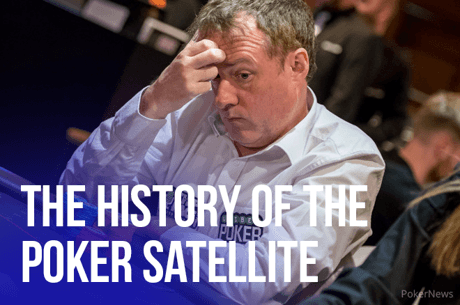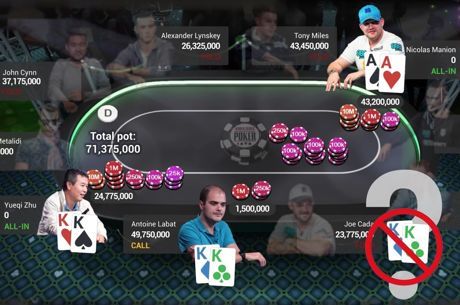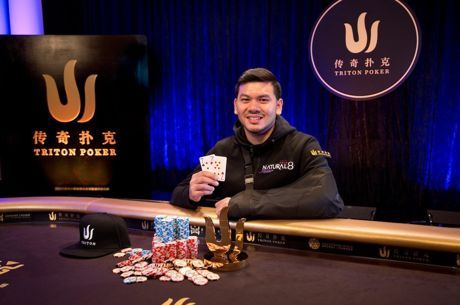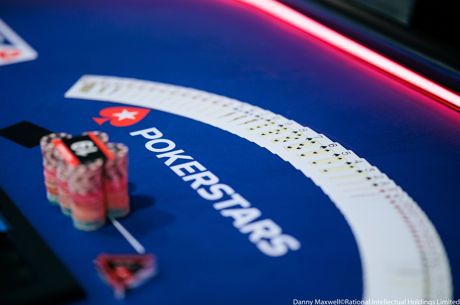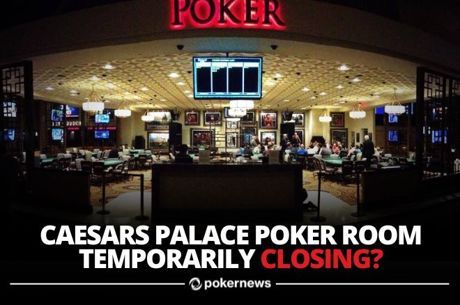Dara O'Kearney Releases Poker Book on Satellite Strategy
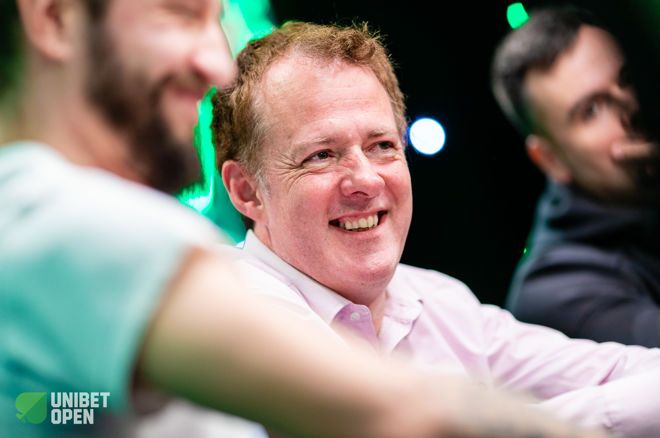
Table Of Contents
Back in the day, the opportunity to build up a poker bankroll via satellites was much more possible, and Irish poker pro and co-host of The Chip Race poker podcast Dara O'Kearney took plenty of advantage. Now, the man who built a successful poker career largely on satellites �� and once won 120 main event seats for the UK & Ireland Poker Tour that had just eight stops �� is sharing his secrets.
Along with Barry Carter, O'Kearney has written and self-published a book divulging his depths of satellite tournament knowledge for recreational and professional players alike to soak up. The full title of the book is Poker Satellite Strategy: How to qualify for the main events of high stakes live and online poker tournaments, and it was released on Feb. 26, 2019.
"There's almost no good content out there on satellite strategy, and because of this the knowledge and skill gaps between pros and recreationals is much wider in satellites than in other MTTs."
While satellites remain a critical element in the poker ecosystem and are often the only way recreational or low-stakes players can take shots at bigger buy-in events, strategy materials on the unique tournament format have been relatively sparse. O'Kearney looks to change that now, giving any player who wants to pony up a few $2/$5 big blinds access to a wealth of knowledge compiled by one of the best to ever specialize in satellites.
"Dara has been ahead of the curve on satellites for years and his results show it. This book will change the way you think about, and play, satellites forever," said friend and collaborator, Daiva Byrne.
According to the book cover, here's what readers can expect to learn:
- Adjustments you need to make from regular tournament play
- What hands to shove, call and fold on the bubble
- When to tighten up and when to keep accumulating chips
- How to adjust against different player types, dynamics and situations
- When it's correct to fold Pocket Aces preflop
That's right, folks. Sometimes it's correct to fold pocket aces preflop, but we'll leave the explanation of that one to the expert. We caught up with O'Kearney to get the full scoop on the writing and publishing of the book, and what he hopes to accomplish with it.
Interview with Dara O'Kearney
What inspired you to write this book? I know you mention a conversation with Carlos Welch in the preface. Can you elaborate on when that took place and any of the contents of that conversation? And why (and how) it lead to deciding to write the book?
Dara O'Kearney: That conversation was in Vegas two years ago. I was staying in a house with Carlos and Andrew Brokos for the WSOP. One morning Carlos was going off to play a satellite to the Main Event. He knew that I used to specialise in satellites so he asked me for some pointers. We had a 20- or 30-minute conversation during which I tried to give him some pointers. Carlos being Carlos, not only did he go off and win a seat to the Main Event, but when I got up the next day, he'd sent me detailed notes of our conversation, and had coined a term for one of the key concepts we discussed (COC, or Chance of Cashing).
I used to specialize primarily in satellites, but by this time I'd moved away from them for a number of reasons (a number of changes made by the sites made them a lot less preferable, and I wanted to travel less for live poker and focus more on online). I found the experience of helping Carlos in whatever small measure I did to qualify for the Main Event incredibly rewarding, so that planted the idea in my head of doing something to pass on the knowledge I'd picked up on satellite strategy to other like-minded players.
"As much as possible we try to explain concepts with examples and illustrative anecdotes, while not shying away from the maths."
I had coached some professional players previously in satellite strategy and they all became top class at them, to the point I decided I needed to stop doing that as I was making the online games I specialized in a lot tougher. But having made the decision to quit satellites, I figured now was a good time to pass on some of the knowledge, so I used Carlos' notes as the starting point for a two-hour webinar on the major strategic concepts.
I developed the webinar thinking it would be a one and done, but when I tweeted it, it filled up instantly, and there was a list of other players who wanted in, so I ended up running another one. And another, and another, and another. I ran the webinar on five consecutive Thursday evenings, but the waiting list kept getting longer. I didn't want to keep repeating the same material every Thursday for the foreseeable future, so instead I recorded the last one and made it available as a video (still available for $75 from [email protected]).
Then last year Barry Carter approached me with the idea of writing a book together. Barry had already collaborated on two bestselling poker books with Jared Tendler (The Mental Game of Poker 1 and 2), so he seemed like an ideal person to collaborate with.
What was the process of drafting and getting it published like and how long did it take?
O'Kearney: It took about almost a year. The way we worked was initially I sent Barry everything I'd produced on satellites �� not just the webinar but quite a few magazine articles, interviews, blog posts and pieces I'd written for my free strategy newsletter. After he'd digested all that, we did a series of Skype calls which were essentially me doing a brain dump and Barry asking lots of questions.
We recorded these so Barry could go back and review them while he wrote them up. He produced a first draft which I then reviewed and rewrote. Barry was keen I put my own personality on it, so while he produced the first draft, I rewrote it in my own style.
What was the biggest challenge in writing the book?
O'Kearney: The biggest challenge was writing about what is a very technical and mathematical topic, but aiming it at recreational players, both in terms of making it comprehensible, and also as much as possible make it an interesting read. So as much as possible we try to explain concepts with examples and illustrative anecdotes, while not shying away from the math. I wanted the book to be as comprehensive as possible rather than just a general guideline, but at the same time didn't want it to read like a dry manual.
What role did Barry Carter play in the book writing?
O'Kearney: As I said the book was Barry's idea to begin with, and he produced the first draft. This was vital because I work much better revising or adding to something rather than starting from scratch (remember, it was Carlos who wrote up the initial notes I used to develop the webinar).
The great thing about Barry is he is exactly the type of player I wanted to aim the book at: an intelligent recreational who doesn't have the time to put in the hours of study the pros do because it's not his job and he has other stuff going on, but has a natural aptitude and can pick up the most difficult strategy concepts if they are properly explained. When I produced the webinar, the goal was to orient it towards recreational players.
I didn't expect other pros to buy it, but as it worked out, almost half the people who attended the webinar and bought the video were pros. The reaction from them was overwhelmingly positive, but recreationals were a little less enthusiastic, leading me to suspect that I didn't quite pitch the material at the level I wanted to. So having someone to essentially act as a recreational representative was vital. I'm basically a math nerd, so if I'd done this book on my own, it would be a lot less comprehensible to the lay person.
Anyone who has listened to the strategy segments we do on the Chip Race (the podcast I make with David Lappin) will know I can disappear down a rabbit hole of jargon and game theory. David is very good at putting it in lay terms and asking the questions a recreational would ask, and that's essentially the role Barry filled on the book. He's very good at pulling me back out of rabbit holes, focusing on the big picture and going "Hang on a minute, what do you mean by that exactly? Can you explain it a bit better?"
"A big part of my motivation for producing articles and material for my newsletter on satellites and the webinar and now the book is to give recreationals a shot at a level playing field."
Barry is also an experienced writer and handled all the technical aspects of writing, publishing and promotion. He also had a brainwave early in the process about how best to organize the material. My webinar is organized linearly: it starts with some general points on satellites, then goes into the strategy in the early stages, then onto the middle part of a satellite, and ends up with the endgame. Barry pointed out that the endgame is actually the most important phase as it's where the biggest mistakes can be made and the biggest edges are possible, so he suggested we start with the endgame and then work back (similar to the way chess is often taught).
This makes sense not just because the endgame is the most important (and it's well over half the material), but also once you have a firm grasp of endgame strategy, it's easier to extrapolate back from that to what your strategy should be in the middle and the start. So this is how the book is structured. Barry's other brainwave was to start with a sort of general guideline chapter explaining all the major concepts. As I said before, I didn't want the whole book to be this, but having it as a chapter out front means players can take a quick dive into a crash course and improve their satellite play immediately, before going on to a deep dive in the rest of the book.
I think for both of us, but certainly for me, one of the most positive things to come out of working together on the book is how much Barry's satellite game improved. I would say Barry now has a better understanding of satellites than most professionals, and I'd like to think that's the best proof of concept given as I said he's the demographic the book is aimed at. Barry's journey from enthusiastic amateur to someone who can discuss the subtlest nuances of strategy with any expert has been a sight to behold.
After we'd finished the book, or thought we had, we identified an extra chapter that needed to be written to complete it properly. I was busy at the Aussie Millions so Barry had a bash at writing it up before we talked it through in detail. It's quite a mathematical chapter so I think we both expected I would have to revise it extensively, but in fact the only changes necessary were cosmetic. That to me proved that Barry had made the full journey to expertise as a result of the material in the book, so I hope that means anyone who applies themselves to it can do the same.
What kind of effect do you think the book might have on the level of competition in satellites, both live and online?
O'Kearney: I think anyone who even reads the "Get started" chapter will improve their game significantly to the point they will be winning players long-term in satellites if they take the concepts on board. I think anyone who studies the entire book and masters the material will crush satellites for the foreseeable future. This is obviously a problem if everyone playing satellites reads the book, but of course that's never going to happen. Satellites will get tougher for sure the more players read the book, but there will always be more players that don't want to read and just want to play.
There was a dark period for satellites a few years ago, around the time I gave them up. Recreationals are not stupid. They can recognize that when they go online and see the same pros who specialise in satellites in all the satellites every night and almost no recreational players, that's not a good situation for them. As a result, recreationals more or less deserted online satellites for a while. They may not have the inclination or time to run nonstop simulations like the pros do, but they want some sort of semblance of a chance.
There's a lot of great training content out there that allows recreationals willing to commit a few hours a week to studying to get better to pull themselves up to be at least competitive with pros, and the last few years have seen serious recreational players improve immeasurably as a result of training sites and free YouTube videos and newsletters and articles. However, the training sites have shied away from satellites for whatever reason, either because it's seen as too small a niche or there aren't enough true experts around willing to divulge their secrets.
"I think anyone who studies the entire book and masters the material will crush satellites for the foreseeable future."
So actually there's almost no good content out there on satellite strategy, and because of this the knowledge and skill gaps between pros and recreationals is much wider in satellites than in other MTTs. As I said, recreationals are not stupid and once they realize this, they'll stop playing satellites. And this is tragic, because the satellite is the format that is tailor-made for recreationals who don't have a big bankroll or budget but want to give themselves a shot at playing big event like the WSOP.
A big part of my motivation for producing articles and material for my newsletter on satellites and the webinar and now the book is to give recreationals a shot at a level playing field. Live poker in particular depends on recreationals as the life blood: if it ever shrinks to the point where it's just pros in hoodies running sims, it's essentially dead.
I honestly believe any recreational who buys the book and studies it will be able to compete on an equal footing in satellites with the pros, and will totally crush recreationals who don't read the book. So I'm hoping this will encourage more people back into satellites, and we will see more recreationals winning seats to big live events. Already people are tweeting at us that the book has revolutionized their game, and they've won seats and packages.
That to me is the biggest reward. Poker strategy books like this one are never going to sell enough to make their authors millionaires, and if the only motive were money, both Barry and I could find much more profitable ways to monetize our time, but as Barry said to me recently, poker doesn't have to be an entirely selfish game. We both like to think the book will have a very positive effect on recreationals satelliting into live events, which in turn will make those events more attractive to pros.
From the book, what would you say is the biggest mistake made by low to mid-stakes players in satellites?
O'Kearney: Getting involved in big pots near the end when they have a seat all but locked up. I once heard a live player who bubbled a satellite complain to his friend about getting his aces cracked.
"I was hoping not to get aces but what could I do? Had to play them."
And I immediately thought, "No, you did not have to play them. Especially against the only guy at the table who could knock you out. The fact that you didn't want aces was the clue: muck those aces!"
That's why on the cover of the book we have a picture of a player doing just that.
Is there anything else about the book you'd like to mention?
O'Kearney: There are a few people who deserve a lot of credit for helping with the book, like Carlos as I already mentioned. Andrew Brokos did an incredibly thorough read through for us and made some suggestions that improved the book a lot. Saron Harford did the great cover for us. David Lappin pitched the exact same idea about a week too late to me, but instead of sulking when I told him I'd already committed to doing it with Barry, he has been ridiculously supportive throughout the whole process.
Similarly Daiva Byrne has helped shape my thoughts on what the book should be, and been incredibly supportive at every stage, down to being the first person to buy the book on Amazon. This, despite the fact she was always getting a free copy. I'd also like to thank all my other friends who are true zealots when it comes to promoting the book, like my buddy Alan Widmann who is pushing it on Twitch and YouTube. (I recorded a hand history review of one of my own satellites which will be available free of charge on his new poker YouTube channel soon.)
And finally, as I said, the real reward for me is hearing success stories from players who read the book, so keep tweeting those at myself and Barry.
Where to Buy
O'Kearney and Carter's book is now available for purchase on Amazon in paperback and for Kindle at $29.18 and $9.99, respectively.

